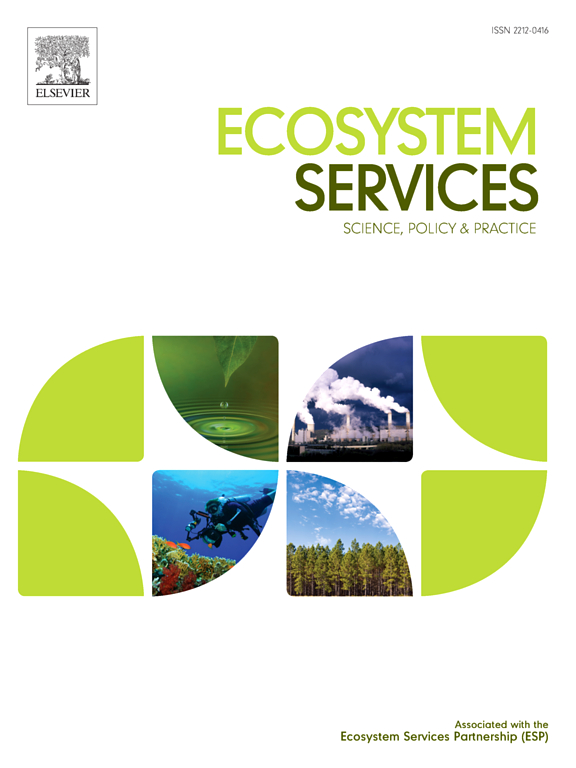采用多指标分配公正法评估布鲁塞尔与学校有关的绿色基础设施效益
IF 6.1
2区 环境科学与生态学
Q1 ECOLOGY
引用次数: 0
摘要
近年来,生态系统服务研究中的环境正义考虑因素越来越多,尤其是在城市评估中。许多研究从住宅角度出发,关注城市绿色基础设施及相关生态系统服务的不平等分布。然而,对于某些人群,如儿童,考虑其他经常光顾的城市环境(如学校环境)对于评估分配环境正义也是至关重要的。虽然有越来越多的研究测量了儿童对学校环境中绿色基础设施的使用和接触情况,但这些评估大多依赖于粗略的绿度指标(如 NDVI)。在这项研究中,我们提出了一种多指标分配公正方法来评估学校的室外环境质量。更具体地说,我们的研究考察了比利时布鲁塞尔首都大区几乎所有小学(408 所)的九个与学校相关的社会环境指标的空间分布,包括绿色基础设施要素(3 个)、调节生态系统服务(2 个)、环境危害(2 个)和社会经济背景(2 个)。双变量和空间回归分析表明,来自富裕家庭的学童通常就读于室外环境质量较好的绿色学校,这些学校的特点通常是校内及周边植被较多、生态系统服务调节水平较高以及环境危害风险较低。我们认为,在规划新的学校绿化计划时,应优先考虑解决这些多方面的环境差异。本文章由计算机程序翻译,如有差异,请以英文原文为准。
A multi-indicator distributive justice approach to assess school-related green infrastructure benefits in Brussels
Environmental justice considerations in ecosystem service research have increased in recent years, especially in urban assessments. Many studies have focused on the unequal distribution of urban green infrastructure and related ecosystem services from a residential perspective. However, for certain population groups, such as children, considering other frequently visited urban settings (e.g. school environments) is also essential to assess distributive environmental justice. While there is an increasing number of studies measuring children’s access and exposure to green infrastructure in school environments, most of these assessments rely on coarse metrics of greenness (e.g. NDVI). In this research, we propose a multi-indicator distributive justice approach to assess schools’ outdoor environmental quality. More specifically, our study examines the spatial distribution of nine school-related socio-environmental indicators, including green infrastructure elements (n = 3), regulating ecosystem services (n = 2), environmental hazards (n = 2), and socio-economic background (n = 2) for nearly all primary school settings (n = 408) located in the Brussels Capital Region, Belgium. Bivariate and spatial regression analyses show that schoolchildren from wealthier families usually attend schools with greener and better outdoor environmental quality, generally characterized by more vegetation in and around the school settings, higher levels of regulating ecosystem services provision, and lower exposure to environmental hazards. We argue that addressing these multi-faceted environmental disparities should be prioritized when planning new school greening initiatives.
求助全文
通过发布文献求助,成功后即可免费获取论文全文。
去求助
来源期刊

Ecosystem Services
ECOLOGYENVIRONMENTAL SCIENCES&-ENVIRONMENTAL SCIENCES
CiteScore
14.90
自引率
7.90%
发文量
109
期刊介绍:
Ecosystem Services is an international, interdisciplinary journal that is associated with the Ecosystem Services Partnership (ESP). The journal is dedicated to exploring the science, policy, and practice related to ecosystem services, which are the various ways in which ecosystems contribute to human well-being, both directly and indirectly.
Ecosystem Services contributes to the broader goal of ensuring that the benefits of ecosystems are recognized, valued, and sustainably managed for the well-being of current and future generations. The journal serves as a platform for scholars, practitioners, policymakers, and other stakeholders to share their findings and insights, fostering collaboration and innovation in the field of ecosystem services.
 求助内容:
求助内容: 应助结果提醒方式:
应助结果提醒方式:


